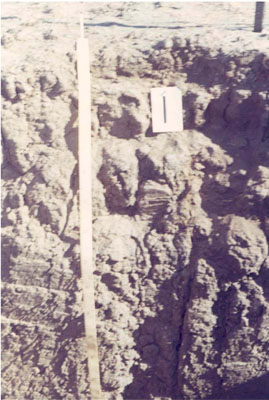IS11
Location: Longerenong.
Australian Soil Classification: Epicalcareous-Endohypersodic, Epipedal, Grey VERTOSOL
Northcote Factual Key: Ug5.28
Great Soil Group: grey clay
Soil Type: Horsham Clay.
General Landscape Description: Anastomotic plain.
Geology: Quaternary Shepparton Formation: fluvial silt, sand and minor gravel.
Soil Profile Morphology:
Surface Soil
| A1 | 0-10 cm | Dark grey (5Y4/1); light clay; cracking and self-mulching surface condition; moderate fine subangular blocky structure; strong consistence dry; slightly sticky consistence wet; very few (<2%) hard carbonate segregations; pH 8.6; sharp and smooth boundary to: |  IS11 Profile |
| Subsoil | |||
| B21 | 10-25 cm | Dark grey (5Y4/1); light clay; subplastic; moderate coarse prismatic, parting to coarse subangular blocky structure; strong consistence dry; moderately sticky consistence wet; very few (<2%) hard carbonate segregations; pH 8.8. | |
| B22 | 25-50 cm | Dark grey (5Y4/1); heavy clay; subplastic; moderate coarse prismatic breaking down to coarse subangular blocky structure; strong consistence dry; moderately sticky consistence wet; very few (<2%) hard carbonate segregations; pH 9.0. | |
| B23 | 50-85 cm | Dark grey (5Y4/1); heavy clay; subplastic; moderate coarse prismatic, parting to coarse subangular blocky structure; strong consistence dry; moderately sticky consistence wet; very few (<2%) hard carbonate segregations; pH 9.4; sharp and wavy boundary to: | |
| B24 | 85-115 cm | Grey (5Y5/1); heavy clay; plastic; coarse lenticular structure (slickensides); strong consistence dry; moderately sticky consistence wet; very few (<2%) hard carbonate segregations; pH 9.6. | |
| B25 | 115-140 | Grey (5Y5/1); heavy clay; plastic; coarse lenticular structure (slickensides); strong consistence dry; moderately sticky consistence wet; very few (<2%) hard carbonate segregations; pH 9.6; gradual boundary to: | |
| B31 | 140-180 | Pale olive (5Y6/3); heavy clay; plastic; coarse lenticular structure (slickensides); pH 9.7. | |
Chemical and Physical Analysis:
Horizon | Sample Depth cm | pH H2O | EC dS/m | Sodium Chloride % | Exchangeable Calcium cmol-/kg | Exchangeable Magnesium cmol-/kg | Exchangeable Potassium cmol-/kg | Exchangeable Sodium cmol-/kg | Total Nitrogen % | Organic Carbon % | Bulk Density | Exchangeable Acidity cmol-/kg | Field Capacity -30okPa | Permanent Wilting Point -1500okPa | Coarse Sand % | Fine Sand % | Silt % | Clay % |
A1 | 0–10 | 8.6 | 0.21 | 0.01 | 22.7 | 11.7 | 2.1 | 1.2 | 0.1 | 0.87 | 1.03 | 2.1 | 39.9 | 23.5 | 3 | 12 | 10 | 73 |
B21 | 10–25 | 8.8 | 0.19 | 0.01 | 21.8 | 12.2 | 1.7 | 2.2 | 0.07 | 0.56 | 1.37 | 1.8 | 40.2 | 23.9 | 3 | 10 | 8 | 78 |
B22 | 25–50 | 9 | 0.18 | 0.03 | 18.9 | 14 | 1.8 | 4.8 | 0.06 | 0.46 | 1.31 | 2.5 | 27.1 | 2 | 11 | 8 | 78 | |
B23 | 50–85 | 9.4 | 0.36 | 0.03 | 12.7 | 14.5 | 1.9 | 8.1 | 0.04 | 0.35 | 1.39 | 27.9 | 3 | 14 | 8 | 73 | ||
B24 | 85–115 | 9.6 | 0.62 | 0.05 | 7 | 14.5 | 1.9 | 12 | 0.03 | 0.26 | 1.47 | 28.7 | 2 | 11 | 9 | 73 | ||
B25 | 115–140 | 9.6 | 0.78 | 0.08 | 5.1 | 14.1 | 1.9 | 14.3 | 0.02 | 0.23 | 27.3 | 2 | 12 | 11 | 73 | |||
B31 | 140–180 | 9.7 | 0.84 | 0.07 | 26.5 | 2 | 11 | 13 | 72 | |||||||||
B32 | 180–215 | 9.6 | 0.97 | 0.12 | 27.9 | 1 | 12 | 13 | 71 |
Management Considerations:
- Cracking clay profile, very high clay percentage
- Alkaline throughout soil
- Friable self mulching surface
- Very high calcium percentage in surface and upper and mid subsoil (to 90cm)
- Yellow hue profile(5Y) and lighter coloured deep subsoil, poorer internal drainage
- Subsoil is strongly sodic and salinity increases at depth, particularly below 50cm
- Very strong consistence when dry, implications for compaction and implement use
- Landform element, plain: poor site drainage


